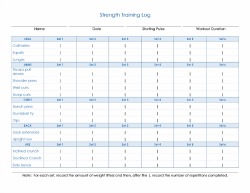Principles of Fitness Training
Understanding the principles of fitness training can help you develop an effective fitness training plan.
There are 4 principles that make up the acronym FITT:
1. Frequency (how often)
2. Intensity (how hard)
3. Time (how long)
4. Type (the type of training - strength, endurance, et cetera)

Frequency
It does matter how often you do and don't exercise - it makes a lot of difference in whether or not you reach your fitness goals or get injured or burnt out.
There are some general guidelines in the principles of fitness training to follow when making your fitness training plan. Again, this can increase or decrease depending on whether you are just getting off the couch and into an exercise routine or are getting ready for a fitness competition - you will be doing some serious gym time!
For your cardio, the general time guidelines are moderate level cardio for 5 days out of the week or for intense cardio, no more than 3 days a week.
If you are looking to lose weight, then doing moderate cardio 6-7 days a week may be in order until you can move up in intensity.
For strength training or building lean muscle, the general time guidelines are 2-4 days per week with 1-2 days of rest in between. You MUST have rest days when lifting weights. Your muscles have to have that recovery time or your gains will be interrupted and you risk being injured.
Intensity
Generally for cardio, you want to use your target heart rate numbers to help you in determining how hard you are working out.
If you are near the lower number, then you are doing the lowest level of intensity exercise. But if you are near your max heart rate, then you can only do short bursts, like sprints at this level.
Vary your intensity levels to stimulate and use different energy systems in your body - your body will use oxygen or no oxygen and different muscle fibers at different intensities.
For measuring intensity in strength training, count the number of exercises you do, the number of reps/sets and the amount of weight you lift.
Do 5-10 exercises in a strength training workout, 1-5 sets, 6-10 reps and start lighter (like a bag of groceries) then add on 2-5 lb plates or increases in dumbell weight as you progress.
Again, these are the guidelines I use. I keep it easy for myself: I do 5 different exercises, 5 sets, 5 reps each and I keep track of what I started at and each week try and add 5 lbs more than what I lifted last week.
Time
For cardio, moderate sessions can be anywhere from 20 to 60 minutes (longer in a marathon!) and for intense sessions where you are exercising near your max heart rate) 15-20 minute sessions are the rule.
Remember, the harder you work, the shorter your workout will be. The easier you work out, the longer it can be.
For strength training, you can do a short or long workout, depending on if you are working out all muscles groups or doing split-training, where you workout one or two muscle groups at a time.
Type
In the principles of fitness training for cardio, the type of exercise is any movement that gets your heart rate up and can be done repetitively to keep your heart rate at that level, like running, riding a bike, dancing or rowing a boat.
For strength training, this includes any exercise where it involves resistance, like in using bands, dumbbells, barbells, weight machines or a pull up bar.
Using a pull-up bar is considered using your body weight as resistance and even though using your body weight is an EXCELLENT form of building strength, you can reach a plateau and lifting weights will allow you to go further in your muscular development.
Remember, our bodies are always trying to reach a state of homeostasis - or where everything is staying the same for awhile or so our body wants to think. You build muscle or go for a jog, your body builds on its capillary beds, for instance, to make sure enough blood gets to the lungs and newly used muscles when the jog happens again.
Basically, your body becomes efficient at the movements, the exercise, and it is easy for you causing you to burn less calories next time and to develop less new muscle. It wants to keep things the same and EASY!
So if you keep switching things up on your body, growth will continue. I'll get more into this on another page how the body reaches these plateaus and how to keep it confused and keep making improvements.
Use the principles of fitness training, or the components of fitness training, to your advantage.
Changing either the frequency, intensity, time or type of exercise will bring changes in your strength, power, flexibility, mobility and endurance.









